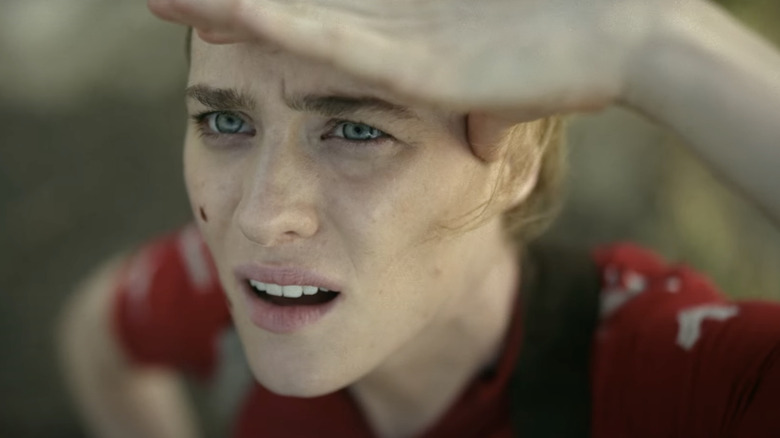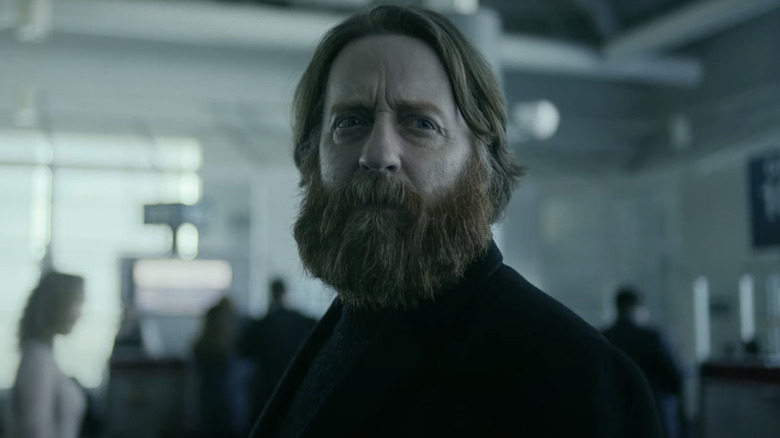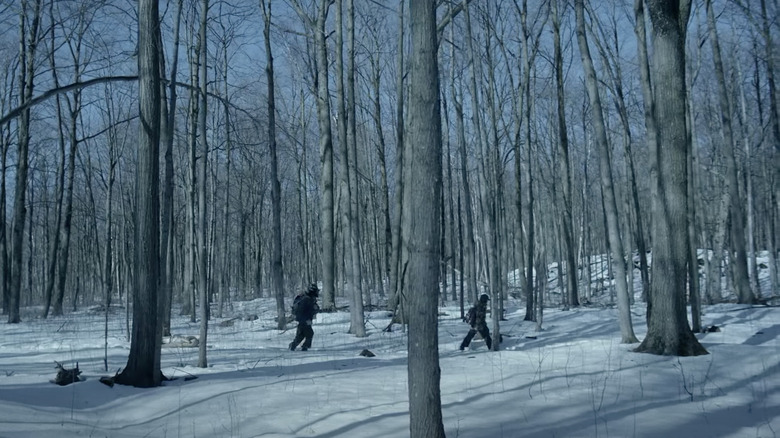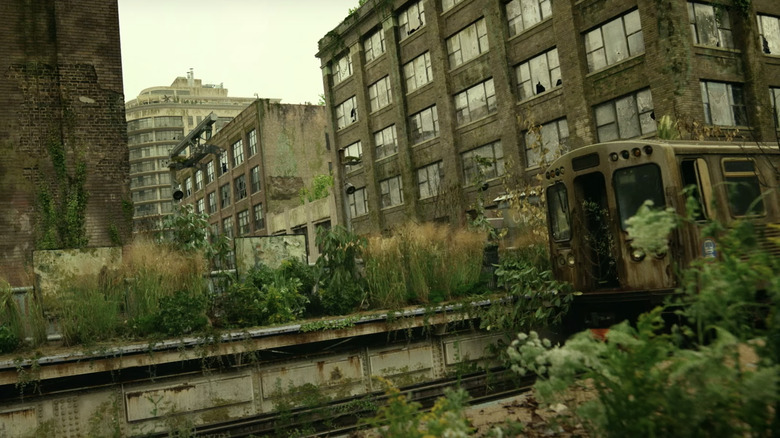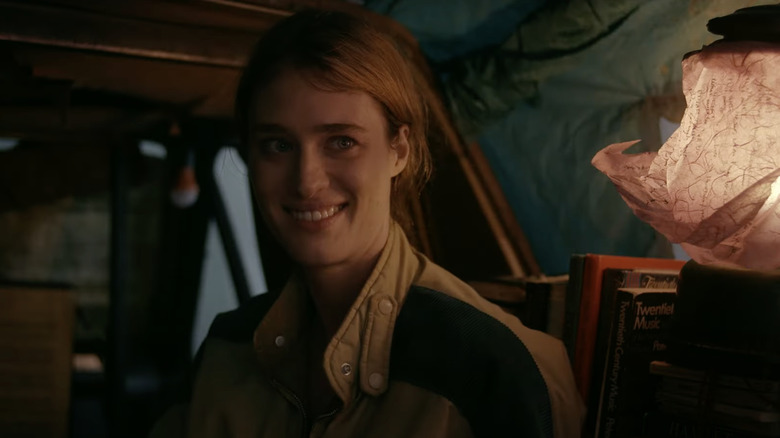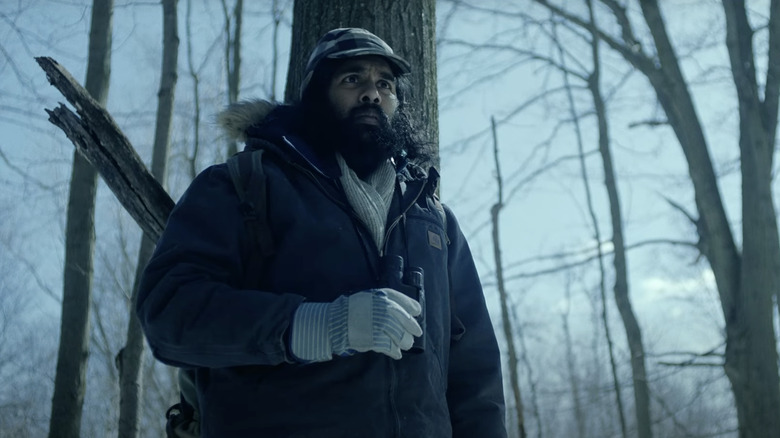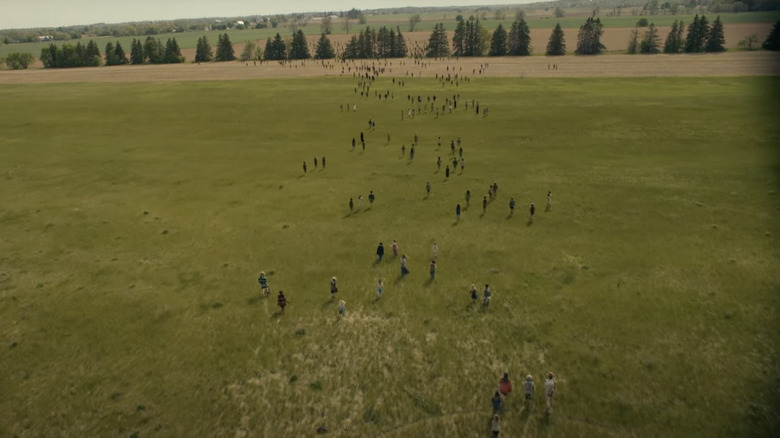Station Eleven Cinematographer On Capturing The Post-Apocalyptic World Of The HBO Max Series [Interview]
"Station Eleven," now streaming on HBO Max (read our review), serves as an antidote to the dour color palette and mood of other post-apocalyptic narratives on television and in film. Laced with humor and heartache, it's perhaps the brightest, most fanciful end-of-the-world drama you'll ever see. The 10-episode miniseries follows several characters and their interconnected lives during a global pandemic and its aftermath.
Needless to say, it's a show that very much mirrors our own reality. "Station Eleven" dropped its first three episodes on December 16, 2021, and it's rolling out new episodes, two at a time, over the next few weeks, all leading up to the finale on January 13, 2022.
I recently caught up with Steve Cosens, one of the show's cinematographers, who shot episodes 2, 5, 9, and 10. He was generous with his time, and over the course of our extensive interview, we covered a wide array of topics, including the show's aesthetic and tone, taking over a whole airport wing, reenacting a speech from "Independence Day," shooting a pandemic series in the middle of a pandemic, and collaborating with the show's other cinematographers, as well as actors like Mackenzie Davis, David Wilmot, and Himesh Patel.
This interview has been edited for clarity.
'We wanted to bring color and playfulness and whimsy'
In the first episode of "Station Eleven," we see this fictional flu pandemic rapidly unfolding in the present. And there are these quick match cuts or flashes forward, but it's not until the second episode, really, that you set us down in this post-apocalyptic world. Can you talk about how you sought to build that world and the characters in it visually?
Yeah, the first meetings that I had with Ruth Ammon, the production designer, and [director] Jeremy Podeswa, and with Patrick Somerville, the writer, a lot of those conversations were about world-building. And what does Year Twenty look like, and what's important to convey in that time? And for Patrick, one of the things that was really important for him is that the future is not daunting. And even though we're in this kind of post-apocalyptic, post-pandemic world, he wanted nature to feel that it's friendly. It's not, you know, it's not to be feared. It's not like some of these other post-pandemic or post-apocalyptic shows where nature is all burnt out and kind of scary.
Like "The Walking Dead" or something?
Yeah, something like that. So that was kind of a stepping-off point, you know, that we, Patrick, wanted it to feel colorful and he wanted the greens to feel lush and not be foreboding. So it was pretty easy, once we knew that, we knew that any place that we went into, yes, it would be broken down or it would be aged. But there would still be some lyricism in the design of the sets or there would be pops of color. There would be some playfulness in those textures. And it was something that Patrick and, well, all the creatives talked about that, is that we wanted to bring color and playfulness and whimsy to the future. And so you'll see, obviously, that a lot of the wardrobe is quite playful and there's color. Everything's not just drained out and foreboding.
'I really wanted to embrace nature'
You're following this troupe of Shakespearean actors, and I thought when the title comes up in episode 2 and they're rolling into town, it was almost like a Mardi Gras atmosphere. But then later, when you get into "Hamlet," there are some very intense emotions going on with Kirsten, played by Mackenzie Davis. What was the process like in terms of finding the visual language to achieve that balance of tone?
Well, the "Hamlet" performances we talked a lot about because we knew that they were both at night, and so the only means to light them for the most part would be fire. And so that was a big conversation that we talked a lot about, especially because the first performance is outside at night and we were concerned it was actually right on the water. And we were concerned about the winds, in particular, that would come up and possibly just blow everything out. So that was how we positioned the stage. You know, the kind of flames that we had and the things that we built around the flames to protect them from wind was obviously important.
In terms of the aesthetic, it was something that was important for Jeremy, and that is, that it was organic. And I would say that the show as a whole has quite an organic feel to it. I used natural light and practicals wherever I could, and I really wanted to embrace nature, and that was kind of in-tone with the themes of the show, too. So wherever I could, whether it was shooting in the airports or even on stage, as much as we could, I would try to incorporate just natural light coming from the outside, coming in. That was true with the Shakespeare pieces, as well.
'We used firelight on her in the flashbacks'
We wanted to just use natural light and let the flickering be alive, and let it be what it is. I would say the tone, the tone of the pieces, you know, it was Shakespeare. They're slightly ... they wanted to stand apart, visually. And really, the set design, being on the stages, being on these cars that convert into the stages, and the lighting kind of is what set it apart from a lot of the other locations. Similarly to how we covered other scenes, it was more static, except for ... in some of the scenes, we shot handheld to kind of mimic some of the shooting in episode 1, where they go into handheld mode when they're onstage.
With this show, there are a lot of interesting juxtapositions, but one that really stood out to me was when you have Kirsten performing ["Hamlet"] and it's intercut with flashbacks to her own life. I thought that was a really interesting way of making these lines of Shakespeare kind of fresh and letting us feel them. How did you arrive at that and those particular juxtapositions of images?
Well, that was actually a decision that was made after, in the edit. Originally, the cutting to her in the past, there were a couple of things that we were going to flashback to. There ended up being a longer sequence now that we cut back to, where you see her with the two brothers and their condo, and that whole sequence was kind of extended out. It was never really intended to flashback that much. But something that we did, and you see it a little bit in the cut, I think, is that with all the firelight that is being used on the stage, we went to young Kirsten in the room, we used firelight on her in the flashbacks when she's in that room.
Oh, really?
Come to think of it, I think it actually got cut out, to be honest. Now that I'm thinking about it. But yeah, we knew that we were going to flashback to her when she was younger. We knew that we were going to be cutting to her memory, so it was really in sort of how we covered it.
'We took over this whole airport'
You mentioned shooting in an airport.
We were in Toronto out at our main airport. They have a whole wing that they have leased to a film company because they just didn't use it. And we were the first production to shoot in this huge wing of this airport and we basically had free reign. We could pull up a plane right into the jet bridges. And we took over this whole airport and designed it and it's quite beautiful.
You were also shooting in Canada in winter and on the water with cranes. What were those experiences like?
Yeah, so the production started shooting in Chicago. Then, the pandemic hits and then, when they picked up production, they moved it up to Canada. I actually live in Toronto, I'm Canadian, and so when they came up here, the timing of it, all of it was going to be shooting in mostly winter up here. The nice part of it is that for the scenes where we needed a lot of snow and a lot of deep snow, we were able to get that not too far north of Toronto, and it really was in the peak of winter. So it was cold and the location that we had was difficult to get into, and it was a real test of the crew at the time, man. It was like, if we can get past this little block of time that we're shooting up here, then we can do anything, because the snow is super deep and it was cold and it was really challenging for the crew. But the location that we actually got, this beautiful cottage in the middle of nowhere, was really worth the battle because it was beautiful.
'It was kind of a road movie'
You have one character on this show who is an artist, but who is working in logistics. So I just wanted to ask you, as a cinematographer and artist, how the logistics of working on this series compared to your previous television experience. Was there a lot more coordination that you had to do with the other DPs because of the time-jumping nature of the show?
Yeah, exactly. You know, because the show jumps forward and backward in time, Daniel Grant, the other DP, and I were always kind of flip-flopping locations. I would go there on one episode in Year Twenty and then he would maybe move in after me and shoot Year Zero there. Sometimes the lighting would have to change, or they'd have to spend a couple down days to redesign it and change the set decorating. And then one of us would move back in and shoot it.
It was kind of a road movie, really, because once we start shooting with the traveling troupe of actors and musicians, they were on the road the whole time and so every week we were in a new place out in the countryside. Just on the road moving a large crew of people, so we actually had to move really quickly and it really required everybody to be at the top of their game in order to just logistically make it all happen. And Daniel and I were sharing a lot of information all the time in order to help each other out and to really slide into these new locations easily.
'That's where all the magic came out'
How did you all delegate who was going to handle what episodes? I know you did the last two, also, and episode 5. Was it just something where you, I don't know, called dibs on what was most appealing to you? How did that work?
Well, it was actually Jeremy, I shot all of Jeremy Podeswa's episodes. He wanted to shoot specific episodes, and so originally, he was going to do 2, 5, 9, and 10. As we got into it, we just realized that Jeremy was going to need to do more work for 9 and 10 and didn't really have the time to shoot 5. Lucy Tcherniak ended up directing 5, and I was really keen to work with her and so that all worked out. I got to do an episode with Lucy and three with Jeremy, and so it was really Jeremy's choice.
You were talking about coming in and shooting in the same locations or coming and going. There are some parts where you seem to have pre-lap dialogue or voices from the next scene coming in, and there's almost this stream-of-consciousness flow of images going on between one time period and another. Did each crew shoot everything for their own episodes, or were you able to kind of share some footage?
For the most part, each block, we shot all our own footage. All of that cross cutting and the kind of jumping back and forth in time was something that, in the editing process, that's where it was refined. And really, that's where all the magic came out.
We knew while we were in production that we would be going back and forth in time. When those moments would happen were not always clear. Sometimes we knew when that was going to happen, but not always. Sometimes we were able to anticipate out that, oh, we're going to be going from this snowy cool exterior winter scene to the interior of an abandoned Kmart. You know, we were able to anticipate what the two looks would be and to kind of play with the different colors and textures in those two scenes.
'A lot of sharing of ideas'
Did you have, like, a DPs' room? I'm just imagining, in the same way that you would have a writers' room, how did you keep up the huddle or keep things together as you were going?
First of all, Daniel and I, we talked several times with [DP] Christian Sprenger, and he sent us mood boards and color boards and images and stuff like that at the beginning of the show. But Christian really said to Daniel and I, especially because, when Christian and [director Hiro Murai] had first started shooting the show, they didn't even have multiple episodes. They didn't even know where it was going. You know, they shot 1 and 3. But they didn't know what in the future was actually even going to happen. So when it moved up here and we had now, you know, the full scripts, Christian was really generous in a way and he said, you know, I trust you, guys. I love your work. Just go for it.
So after we saw episode 1 and 3, and then we all had a meeting and talked a few times, Daniel and I just said, OK, well, this is what we're going to do and after that it was kind of Daniel and I just continually updating each other.
And we'd have the odd meeting, but mostly it was conversations on the phone while Daniel was, you know, at 5:00 AM, going to one other location, then I was coming back from some other place. But a lot of sharing of ideas and really just being as generous as we could with each other.
'It was from the scripts that I started to take all my cues'
You have this scene where the guy is auditioning for the Traveling Symphony, and it's a funny moment where he uses Bill Pullman's "Independence Day" speech for his monologue.
Yes, yes, I love that scene.
I was just wondering, did you go back and watch that scene in the 1996 movie? Were you in any way referencing it, or did you just try to be in the moment with the actors since it's more about the memory of that scene among these characters?
Yeah, I always really loved that scene and I'm sure I've seen "Independence Day" when I was 12 or something, but no, I didn't go back and watch it. But we knew that it was going to have its own sort of isolated ... you know, that moment was going be special for him. And when I saw that they had put that texture of an actual microphone on there, I was so happy. It was such a great, you know, aesthetic choice, acoustic choice. And I love that scene and I love how it goes from there into the music that leads into the aerial shot for the first time.
You were also the DP for "Big Driver," a Stephen King adaptation.
Ah, yeah, a long time ago.
With projects like that and "Station Eleven," where you're drawing from a novella or a book, are you consulting the original stories much for visual ideas? Or do you have some other springboard you're using?
Well, I had read the book, but really, once I started getting Patrick's episodes, his were so powerful and so clear, and they had different locations, and it's just, they're different. The essence of them is the same as the novel, but they're different, and I really just started to dive into the scripts. It was from the scripts that I started to take all my cues for visuals and the world-building.
'We were shooting, in the middle of a pandemic, a series about a pandemic'
I'm sure you might be getting this question a lot, but you had mentioned it earlier. How did the real-life pandemic impact this production? You were in production, and then all of a sudden, life starts imitating art in a big way. Did you have to readjust a lot, and did that factor into the storytelling approach? Or was it something you felt more just in the shooting schedule and set conditions?
So, the fact that we were shooting, in the middle of a pandemic, a series about a pandemic, for everybody, it was quite emotional, I would say. And we all knew the writing was so good, and we were also excited by what we were making. At the same time, it was one of the most, I think everybody on this crew has said it was one of the most beautiful times of their lives and the most difficult, and I love that quote.
It's actually in the trailer, I think, when Jeevan's brother says that, and we all kind of felt that. You know, it was really difficult to make and really challenging, but at the same time, we felt it was really important to put this message out.
For other cinematographers or aspiring cinematographers who might be reading this, can you talk about using the ALEXA Mini and then some of those other vintage lenses that you used?
Yeah, well, we shot the ALEXA Mini and we shot the LF, so it's a large format ALEXA Mini, which just gives you a really nice depth of field, nicer color. It's just rich and beautiful. The lenses, we used a couple of different lenses. We used the Tribe7 Blackwings, they're called. That was one set. And then we also had another set of Masterbuilt lenses. Both of the sets were sort of tuned to have vintage qualities. They were sort of softer on the outsides, softer around the edges of the lens. And I would say that they're more susceptible to flaring, but also just, like, a nice creamy softness to them. For myself and Daniel, we just felt it was the first time we'd both used these lenses, and we really fell in love with them and I thought it just lent a nice patina to the show.
'Shooting documentary, I always recommend it to younger DPs'
You also have some documentary experience in your background. Did any of that skill set come in handy for "Station Eleven?"
Well, for me, I have shot a fair bit of docs in my life, and it has always helped me in my shooting of drama. Because when you're shooting documentary, you need to learn to be flexible and adaptable and to be able to shift when things change. And those skills are something that I bring to drama all the time. And I would say probably one of my strengths is that I am easy to just move or adapt and to move on to something else if things change, and to let an actor decide to do something different on set, and to move to a different place in the set and know that, OK, I can, I've got to change my lighting setup.
So yeah, shooting documentary, I always recommend to younger DPs to try and shoot documentary because it really just allows you to move, move with people, too, especially if you're shooting verité. If you're following handheld and you're moving with somebody and you need to move into a house, how do you situate yourself in relation to that person and the light? So yeah, I use my skills from documentary all the time.
I saw you have a music coordinator, and I was just wondering, is everything shot and edited by the time the music comes in or were you working closely to kind of synchronize the images with the musical score?
I think, because there's an orchestra in the film, often they needed to be able to sync up the music and what they were playing and what some of the different artists were playing in some of these scenes. So the musical coordinator was there to kind of facilitate that. But all of the score was done after. Although once in a while Patrick would send a little clip of some of the music that was being done, which was really exciting because it was a really beautiful score that was happening.
'The whole cast was just so easygoing and generous'
Can you talk about working with some of the actors that you did? In the second episode, you introduce us to Lori's Petty character, and before that, we've seen a glimpse of Mackenzie Davis, but you kind of help us to get to know her better. What was it like working with them and the other actors?
Yeah, well, Mackenzie is a wonderful actress, and, really, such a grounded, gentle energy on set, and really, so generous with the other actors and with crew. And one thing Mackenzie did that I always really appreciated is that she started to do this thing where, I think it was Friday afternoons, or just at lunch, we would all stand in a big circle. And that one day, I think she chose normally, somebody would step into the middle of the ring and remove their mask so that people, the whole crew, could see what their face looked like. Because we were all of course totally covered.
Everybody would, you know, you'd get in the middle, you'd be all shy and self-conscious and you'd take your mask off. And everybody would applaud, and then you put your mask back on and go on with the day. But we started to do that every Friday and it was such a beautiful thing that she initiated, and it really made us all realize just also the value of connecting with each other. And seeing each other without a mask and the importance of it.
And then the other actor that I worked with quite a bit was David.
David Wilmot?
Yeah. And you know, David, I'm pretty sure he comes from a theater background, but he was amazing.
He, so many times, really just blew me away and also was really generous with the other actors. And I would say that, generally speaking, the whole cast was just so easygoing and generous and really understanding that we were shooting in difficult conditions. And really, just being part of the team and not separating themselves from the crew. We were all aligned, energetically, I would say.
'I spent a lot of time just observing nature'
I want to actually mention another actor and that is Himesh Patel, too, because I did quite a bit of work with him, and in fact, episode 9, that is kind of the climax of his character in episode 9. He's such a wonderful, generous, vulnerable actor and it was such a pleasure to work with him. Really, really special guy.
I want to steal a question here from the Team Deakins podcast. I don't know if you ever listen to that.
Yeah, yeah, yeah.
They always start off every episode where they're asking just how the person got to where they are. How did you get to where you are? I mean, you've had a long career now for, it seems like 20 years. How did you find this career and then how did you get to this point where you're doing this show?
Well, I went to an art school. Going back to my childhood, I was born in Alberta, on the prairies. And from there, I lived there for several years, and then my dad was an RCMP, a policeman. And we moved up to Iqaluit in the far north of Canada, which is an island which is just tundra and ocean. That's it. And then from there we moved to the Yukon, which was also just a small village and it's kind of, you know, just the wilds of northern Canada. And so, for the really formative years of my life, I didn't have any TV, I was really just kind of out with nature and being at one with nature. It sounds really cheesy, but you know, I spent a lot of time by myself and I spent a lot of time just observing nature with big sky.
I've often said that on the prairies, especially up on Baffin Island, which is where Iqaluit was in the north, your eye kind of gets a chance to develop, like the world comes at you very slowly. And I really do credit my early formative years of living in these wide-open spaces. It's just influencing the way that I see the world and my temperament.
'I really felt connected to it'
As I got older and I developed an interest in film and photography, I went to an art school in Vancouver called Emily Carr College of Art and Design. And it was a primarily experimental college where really the focus was on process and I always found that when I got into the film industry, that experience of having honored process really served me well, because I would get onto a set and I would just be able to be more patient and more flexible and just roll with things because I was used to this, I guess. My creative DNA was in honoring process. Instead of having this idea that something should be a certain way, I would just go into something, being more open to see how it would flow.
That's always been something that I find directors have often said to me, they've just always told me that they liked that I'm collaborative and easygoing. And I think a lot of that comes from my, a, background and, b, my training.
When it came to "Station Eleven," especially because so much of it was out in nature, like, I love photographing nature, and so the fact that a lot of these scenes I was doing were out in nature was a real pleasure because I really felt connected to it.
'This show started with Christian Sprenger and Hiro Murai'
This show started with Christian Sprenger and Hiro Murai. They shot episode 1 and episode 3 and they kind of established this look. When eventually the show moved up to Toronto and I saw those two episodes right away, I was like OK. I'm good. I love how this looks, they're speaking the same language as me. I can roll into this show no problem, and it wasn't even that I had to think about how I was going to do it. It was just I felt so aligned with Christian and Hiro's aesthetic that it was so easy to just jump on board. But those guys really set the tone, and especially, the one thing I noticed about the show, is the pacing. A lot of shows, there's a lot of editing, and there's a lot of impatience, and I find that in "Station Eleven," it sits back a little bit, and it lets things come at you a little bit, which I really appreciate.
It was something that I really held onto when we were shooting. It's just this idea of not over-covering it. Knowing that, OK, we want to sit and we just want to watch these two people talk. We don't necessarily want to get into two sizes of coverage, you know. And also, Patrick, that was something really important to him, too. He wanted to see wide shots. He wanted to feel the world. He didn't always want to just be in on people's faces. And he really helped set the tone and the pacing of the show, which are really something that I think makes it stand apart. And I really appreciate it.
The first three episodes of "Station Eleven" are streaming now on HBO Max.
